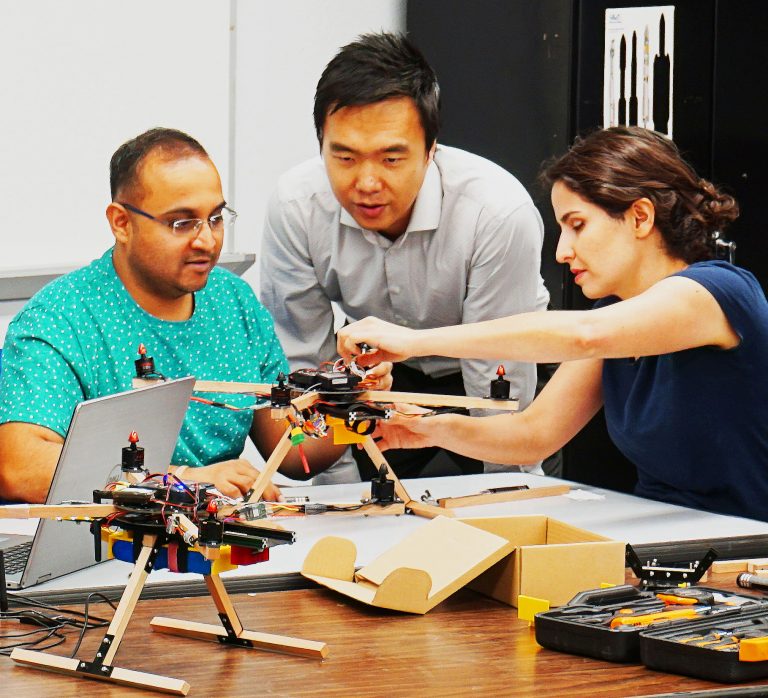By: Linda Fresques
 |
|
| New Mexico State University Mechanical and Aerospace Engineering Professor Liang Sun, center, works on a drone with electrical engineering students Deepak Gala, left, and Arezoo Samiei. (NMSU photo by Linda Fresques) JAN18 | |
|
|
Liang Sun, an assistant professor in the Mechanical and Aerospace Engineering Department in the New Mexico State University College of Engineering, is bringing the interdisciplinary nature of real-world engineering to his students.
Sun’s teaching, research and projects are focused on autonomous unmanned systems, such as drones and robots, which rely on a number of engineering disciplines, as well as computer science. An NMSU faculty member for two and half years, Sun runs the Autonomous Systems Laboratory. He is currently leading research projects with the goal to make unmanned systems truly autonomous.
“We want to develop an unmanned system to do the work that humans have difficulty to do without huge risks, completing tasks with as little human intervention as possible,” Sun said. Such systems would be useful in first-responding scenarios such as earthquakes and fires, or search and rescue operations.
Sun is developing a ground robot that can hear, mimicking the ability of mammals to identify the location of something through the sound it produces. This bio-inspired approach uses only two microphones, just like ears, that can discern the location of multiple sound sources. In a search and rescue operation, the robot can sense the environment and find the target of interest – perhaps a human calling out or blowing a whistle. Other uses include localization and mapping or abnormality detection, such as air leaking in a spacecraft.
“Through sound localization, there is no need for line of sight, a must for vision-based approaches. It is inexpensive, portable and is complementary with machine vision,” Sun said.
Working with NMSU’s Arrowhead Center, Sun has just begun the process of investigating the commercial viability of this research. Arrowhead’s Launch program has been identifying and providing commercialization support to promising early-stage technologies since 2011.
Another of Sun’s projects has already garnered a provisional patent with Arrowhead’s assistance: tethered drones, just like kites, to resolve several concerns of drones.
“The longest duration of flight for drones is presently about 30 minutes. They also have a payload limit of five to ten pounds,” explained Sun. “If you lose control of them, they could be lost or cause a hazard by hitting powerlines, buildings or humans. They rely on the global positioning system, known as GPS, to identify where they are.”
The tether could serve as a powerline, enabling them to run 24-7. Eliminating the battery would allow for a more powerful motor that would support a bigger payload. The physical tether connection can be used to locate a lost drone or prevent drone mishaps. The drone can identify its location through the tether by applying estimation techniques.
Through interviews with some 30 potential customers, this project holds promise for market potential.
A company is interested in using a tethered drone to help map the nation’s railway systems. Instead of using drones to laboriously map out rail lines by scanning large swaths of land, the drone could simply be tethered to the front of the trains that could map as they travel.
NMSU’s Police Chief Steven Lopez has shown interest in using the tethered system for search and rescue operations.
Sun is leveraging funding from federal agencies and industrial partners to support these projects.
Each project involves both graduate and undergraduate students. Sun has extended exposure of this interdisciplinary research to numerous students through his courses and capstone projects.
Capstone projects are the culminating experience of all engineering undergraduates’ academic life, giving them an opportunity to apply the knowledge gained through coursework to solve a real-world problem through engineering design. Teams of seniors collaborate on projects in the fall and spring semesters of their final year. The tethered drone has already been the topic for two past capstone projects and will be again this semester.
Sun teaches two courses that build on the interdisciplinary concept through hands-on experiential projects. ME 210, Electronics and Systems Engineering, introduces entry-level mechanical and aerospace engineering students to fundamentals in electronics and engineering and management of complex systems. Students in this course assemble a robotic car with basic sensors for obstacle avoidance and line tracking.
Students in ME 487, Mechatronics, combine mechanics and electronics in flying vehicles, such as unmanned aerial vehicles and advanced ground robots.
“I want to give students the opportunity to experience this cutting-edge, interdisciplinary research by incorporating it into my teaching,” Sun said.
Offering students majoring in a variety of engineering disciplines the opportunity to work together is an important component of making capstone projects more attuned to real-life experience. NMSU’s College of Engineering is aggressively pursuing industry partnerships to sponsor interdisciplinary capstone projects.
“It’s not productive for students to work in their own silos,” said College of Engineering Dean Lakshmi Reddi. “They will be unpleasantly surprised when entering the workforce because engineering problems are always multidisciplinary.”
“Eye on Research” is provided by New Mexico State University. This week’s feature was written by Linda Fresques of the College of Engineering.
Follow NMSU News on Twitter: http://twitter.com/nmsunews
Follow NMSU News on Facebook: http://www.facebook.com/NMSUNews
